Oldenburg |
|
|
|
| Übersicht – Contents: | |
Diese Seite ist Teil des Projektes
Oldenburg |
|
|
|
| Übersicht – Contents: | |
Flaggen – Flags: |
|
|
als Grafschaft im Heiligen Römischen Reich Deutscher Nation unter dem Haus Oldenburg
– as county in the Holy Roman Empire of German Nation under the house of Oldenburg: |
|
 |
bis/to ca. 1625, Landesflagge – flag of the country, Quelle/Source: World Statesmen |
 |
ab/from ca. 1625, Landesflagge – flag of the country, Quelle/Source: Deichatlas von Musculus (1625), nach: schmid-ol.de |
 |
Landesfarben – colours of the country, Quelle/Source: Flags of the World |
|
unter den Dänischen Königen aus dem dem Haus Schleswig-Holstein-Gottorf – under the Danish kings from the House of Schleswig-Holstein-Gottorf: |
|
 |
1667–1773, Landesflagge – flag of the country, Variante(?), Quelle/Source: nach by: World Statesmen |
 |
1667–1773, Landesflagge – flag of the country, Variante(?), Quelle/Source: nach by: Hermann Lübbing (Archivdirektor des Staatsarchivs Oldenburg), 1953, nach: schmid-ol.de |
|
als Grafschaft (ab 1777 Herzogtum) im Heiligen Römischen Reich Deutscher Nation unter dem Haus Schleswig-Holstein-Gottorf - as county (from 1777 duchy) in the Holy Roman Empire of German Nation under the House of Schleswig-Holstein-Gottorp: |
|
 |
Landesfarben – colours of the country, Quelle/Source: Flags of the World |
 |
1774–1804, Staatsflagge an Land – state flag ashore, Seitenverhältnis – ratio = 3:5, Quelle/Source, Ralf Stelter, 13 Feb 2001 on: Flags of the World |
 |
1774–1804, Staatsflagge zur See – state flag offshore, Seitenverhältnis – ratio = 3:5, Quelle/Source, Ralf Stelter, 13 Feb 2001 on: Flags of the World |
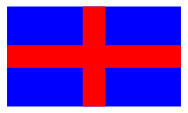 |
1776–1810, Lotsen(ruf)flagge – pilot flag, Seitenverhältnis – ratio = 3:5, Quelle/Source: nach by: schmid-ol.de |
 |
1804–1810, Staatsflagge an Land – state flag ashore, Seitenverhältnis – ratio = 2:3, Quelle/Source: Mattern und Neubecker, nach by: schmid-ol.de |
 |
1804–1810, Staatsflagge zur See – state flag offshore, Seitenverhältnis – ratio = 3:5, Quelle/Source: Mattern und Neubecker, nach by: schmid-ol.de |
 |
1777–1823, Standarte des Herzogs – standard of the Duke, Seitenverhältnis – ratio = 2:3, Quelle/Source: herzogl. Haus- und Central-Archiv, nach by: schmid-ol.de |
|
zwischen 1811 und 1813 war das Land von Frankreich annektiert between 1811 and 1813 the country was annexed by France: |
|
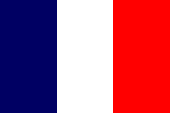 |
1810–1913, die Flagge Frankreichs – flag of France, Quelle/Source: Corel Draw 4 |
|
als Großherzogtum im Deutschen Bund unter dem Haus Schleswig-Holstein-Gottorf - as grand duchy in the German Confederation under the House of Schleswig-Holstein-Gottorp: |
|
 |
Landesfarben – colours of the country, Quelle/Source: Flags of the World |
 |
1815–1866, Staatsflagge an Land – state flag ashore, Seitenverhältnis – ratio = 3:5, Quelle/Source, Ralf Stelter, 13 Feb 2001 on: Flags of the World |
 |
1815–1866, Staatsflagge zur See – state flag offshore, Seitenverhältnis – ratio = 3:5, Quelle/Source, Ralf Stelter, 13 Feb 2001 on: Flags of the World |
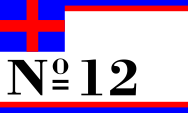 |
1815–1866, Handelsflagge mit laufender Nummer – merchant flag with serial number, Seitenverhältnis – ratio = 3:5, Quelle/Source: nach by: schmid-ol.de |
 |
1815–1866, Lotsen(ruf)flagge – pilot flag, Seitenverhältnis – ratio = 3:5, Quelle/Source: nach by: schmid-ol.de |
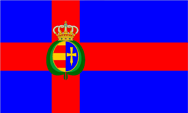 |
1823–1829, Standarte des Herzogs – standard of the Duke, Seitenverhältnis – ratio = 3:5, Quelle/Source: herzogl. Haus- und Central-Archiv, nach by: schmid-ol.de |
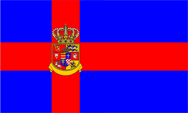 |
1829–1853, Standarte des Großherzogs – standard of the Grand Duke, Seitenverhältnis – ratio = 3:5, Quelle/Source: nach by: schmid-ol.de |
 |
1853–1882, Standarte des Großherzogs – standard of the Grand Duke, Seitenverhältnis – ratio = 3:5, Quelle/Source: nach/by: Flags of the World |
|
als Großherzogtum im Deutschen Reich unter dem Haus Schleswig-Holstein-Gottorf - as grand duchy in the German Empire under the House of Schleswig-Holstein-Gottorp: |
|
 |
Landesfarben – colours of the country, Quelle/Source: Flags of the World |
 |
1871–1918 Landesflagge – flag of the country, Seitenverhältnis – ratio = 3:5, Quelle/Source: nach/by: Flags of the World |
 |
1871–1919 Staatsflagge an Land – state flag ashore, Seitenverhältnis – ratio = 3:5, Quelle/Source: nach/by: Flags of the World |
 |
1902–1919, Seedienstflagge – official flag offshore, Seitenverhältnis – ratio = 2:3, Quelle/Source: Wikipedia (D) |
 |
1882–1918, Standarte des Großherzogs – standard of the Grand Duke, Seitenverhältnis – ratio = 1:1, Quelle/Source: nach/by: Flags of the World |
 |
1882–1918, Standarte des Erb-Großherzogs – standard of the Heir Grand Duke, Seitenverhältnis – ratio = 1:1, Quelle/Source: nach/by: Flags of the World |
 |
1882–1918, Standarte der Herzöge – standard of the Dukes, Seitenverhältnis – ratio = 1:1, Quelle/Source: nach/by: Flags of the World |
|
als Freistaat im Deutschen Reich - as free state in the German Empire: |
|
 |
Landesfarben – colours of the country, Quelle/Source: Flags of the World |
 |
1918–1934, Landesflagge – flag of the country, Seitenverhältnis – ratio = 3:5, Quelle/Source: nach/by: Flags of the World |
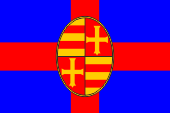 |
1919–1926, Seedienstflagge – official flag offshore, Seitenverhältnis – ratio = 2:3, Quelle/Source: Wikipedia (D) |
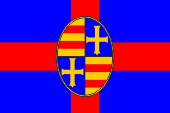 |
1926–1933, Seedienstflagge – official flag offshore, Seitenverhältnis – ratio = 2:3, Quelle/Source: Wikipedia (D) |
 |
1933–1935, Seedienstflagge – official flag offshore, Seitenverhältnis – ratio = 2:3, Quelle/Source: schmid-ol.de, Flags of the World |
|
im Land Niedersachsen in der BRD - in the country of Lower Saxony within FRG: |
|
 |
Flagge
des ehemaligen Landes Oldenburg – flag of the former country of Oldenburg Seitenverhältnis – ratio = 3:5, Quelle/Source: nach/by: Flags of the World |
|
|
|
Bedeutung/Ursprung der Flagge – Meaning/Origin of the Flag: |
|
| Bis 1667 entsprachen die Landesfarben der Grafschaft Oldenburg den Farben und dem Wappen der Grafen von Oldenburg, auf Gold zwei rote Balken. Das Haus starb 1667 aus. | To 1667 the colours of the County of Oldenburg corresponded to the colours and the coat of arms of the Counts of Oldenburg, on gold two red bars. The house vanished in 1667. |
| In der Zeit, in der das Land zur Dänischen Krone gehörte, wird eine dänische Flagge erwähnt, ein weißes Kreuz auf Rot und in der Oberecke das Oldenburger rote Kreuz auf Blau. Man spricht aber auch von einer farbigen Umkehrung der dänischen Flagge, also weißes Kreuz auf Rot! |
In the period in which the country belonged to the Danish crown, a Danish flag is mentioned, a white cross on red and in the upper corner the red cross of Oldenburg on Blue.
Other sources mention a reversal coloured Danish flag, a white cross on red! |
| Die Landesfarben von Oldenburg entsprechen den Farben und dem Wappen des ehemaligen Herrschergeschlechts, der Großherzöge von Oldenburg aus dem Haus Holstein-Gottorf, in dem Blau/Gold (Holstein) und Weiß/Rot (Schleswig-Gottorf) kombiniert wurden. | The colours of Oldenburg correspond to the colours and the coat of arms of the former sovereign-lineage, the great-dukes of Oldenburg from the house Holstein-Gottorf, as blue/gold (Holstein) and white/red (Schleswig-Gottorf) were combined. |
| Entsprechende rot-blaue Flaggen sind ab dem 17. Jahrhundert überliefert, aber auch Flaggen mit zwischen neun und zwölf blauen, roten und gelben Streifen. | Such red-blue flags are known from the 17th century, but also flags with between nine and twelve blue, red and yellow stripes. |
| Die Standarten des Großherzogs, seines Erben und die der Prinzen (Herzöge) wurden 1882 eingeführt. Sie zeigen den gleichen Grundaufbau, das rote Kreuz auf Blau, in der Mitte das mittlere Wappen der herrschenden Dynastie, des Hauses Oldenburg, umgeben von der Kette des Hausordens des Hauses. Die Anzahl der Kronen auf der Standarte unterscheidet die dynastische Stellung. Die Quellenlage zu diesen Standarten ist recht dürftig, jedoch fällt auf, dass die Standarten in einem helleren Blau erscheinen sollen als für Oldenburg üblich. Dafür gibt es keinen heraldischen Grund, wahrscheinlich eher einen praktischen. Im Jahr 1882 wird man je eine der Standarten in Handarbeit produziert haben, und als Grundlage ein wahrscheinlich mit Indigo blaugefärbtes Gewebe genutzt haben, das nach 35 Jahren, zum Ende der Monarchie, nicht mehr ganz so frisch aussah. | The
personal standards of the Grand Duke, of his heir and of the princes (Dukes) were
introduced in 1882. They show the same basic structure, the red cross on
blue, and in the center the middle coat of arms of the ruling dynasty, the
house of Oldenburg, surrounded by the collar of the House Order of the house
of Oldenburg. The number of crowns on the standard distinguishes the
dynastic position.
The sourcing material for these standards is quite rare, but it seams that the standards have to appear in a paler blue than usual for Oldenburg. There is no heraldic reason for that, probably more a practical. In 1882 they will have sewed each one of this standards, and they will have used as the basic material a probably with indigo dyed blue bunting, which looked no longer so quite fresh at the end of the monarchy, after 35 years. |
| Im Jahre 1933 ergriffen die Nationalsozialisten die Macht in Deutschland, was sich in einer Übergangsphase bis 1934 im Aussehen von vielen Wappen und Flaggen bemerkbar machen sollte. Auf den Dienstflaggen wurde nun eine Darstellung des Reichsadlers verwendet, so wie sie auf der Flagge des Reichspräsidenten zu sehen war. Der Adler wurde ohne Schild, nur auf einer weißen Scheibe, ein wenig außer der Mitte in Richtung Fahnenmast verschoben platziert. |
In 1933, the National Socialists seized power in Germany, which was to be noticeable in a transitional phase until 1934, in the appearance of many coats of arms and flags.
On the official flag now was in use a representation of the imperial eagle, as it could be seen on the flag of the President. The eagle was placed – with no shield, just on a white plate – a little bit out of the center moved toward the flagpole. |
|
Für die Nationalsozialisten galten die föderale Struktur des Deutschen
Reiches, seine historisch gewachsenen Länder, als überholt, als Relikte
einer zu überwindenenden Vergangenheit.
In diesem Sinne wurden mehrere Gesetze erlassen, am 31.03.1933 das 'Vorläufige Gesetz zur Gleichschaltung der Länder mit dem Reich', am 07.04.1933 das 'Zweite Gesetz zur Gleichschaltung der Länder mit dem Reich' und schließlich, am 30.01.1934 das 'Gesetz über den Neuaufbau des Reiches'. Die föderale Länder-Struktur des Deutschen Reiches wurde damit durch die Gaue der NSDAP abgelöst, die Länder wurden bedeutungslos. Ämter und Behörden hatten ab jetzt die Hakenkreuzflagge als Dienstflagge zu verwenden, und zwar bis zum 15. September 1935, als mit dem Reichsflaggengesetz eine Dienstflagge für alle Ämter und Behörden des Reiches geschaffen wurde. Die Ministerpräsidenten der Länder, ab spätestens 1933 alle von der NSDAP – und dann meist Reichsstatthalter genannt – blieben jedoch bis 1945 im Amt. |
For the National Socialists, the federal structure of the German Empire,
its historically grown countries, was considered as outdated, as relics
of a past to be overcome. In this sense, several laws were enacted, on 31st of March in 1933 the 'Provisional Law for the phasing of the countries with the Empire', on 7th of April 1933 the 'Second Law for the phasing of the countries with the Empire' and finally, on 30th January in 1934 the 'Law on the rebuilding of the empire'. Thus, the federal structure of the German Empire was replaced by the gau-structure of the NSDAP, the countries became meaningless. From now on, offices and authorities had to use the swastika flag as official flag, until September 15th in 1935, when by the flag-law was legislated a new created official flag for all the offices and authorities of the empire. The prime ministers of the countries, which latest in 1933 all came from the NSDAP – now mostly called Reichsstatthalter (maybe translated as 'governor') – however remained in office until 1945. |
| Die entsprechenden Landesfarben galten mit Einschränkungen zwar weiter, auf jeden Fall aber nicht in Form von Flaggen. Sie wurden z.B. vereinzelt an Uniformen der SA oder bei bestimmten Dienstgraden der Hitlerjugend in der Brustschnur verwendet. | The corresponding country colours continued, with restrictions, but definitly not in the form of flags.
They were used, for example, occasionally on uniforms of the SA or in some ranks of the Hitler Youth in the breast cord. |
| Nach dem Krieg wurde die Verwaltung innerhalb des Deutschen Reiches neu aufgebaut, und zwar lokal, über die Struktur der Länder. Das waren teilweise alte Länder, teilweise wurden neue Länder geschaffen. Dabei besann man sich oft der alten Landesfarben und reaktivierte sie – oder man schuf neue – für eingeschränkte hoheitliche Aufgaben, die der Kontrolle durch die Alliierten unterstanden. Mit der Gründung der BRD und der DDR wurde für beide Gebilde eine interne Länderstruktur final festgelegt und es wurden entsprechende offizielle Flaggen für die Länder eingeführt. |
After the war, the administration
within the German Empire was rebuilt, but locally, following the structure of the countries. These have been partly old countries, and some new countries were created. Sometimes they bethought the old country colours and reactivated them – or they created new ones – for limited sovereign duties, which were under the control of the Allies. With the founding of the FRG and the GDR, an internal country-structure was finalised for both entities and corresponding official flags were introduced for these countries. |
| Quelle/source: Volker Preuß, Jürgen Kaltschmitt, Uniform-Fibel | |
Wappen – Coat of Arms: |
|
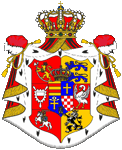 |
Wappen Großherzogtum Oldenburg – coat of arms of Grand Duchy of Oldenburg Quelle/Source: Wikipedia (DE) |
 |
Kleines Wappen Großherzogtum Oldenburg – lesser coat of arms of Grand Duchy of Oldenburg Quelle/Source: Wikipedia (DE) |
 |
Wappen Freistaat Oldenburg – coat of arms of Free State of Oldenburg Quelle/Source: Wikipedia (DE) |
Bedeutung/Ursprung des Wappens – Meaning/Origin of the Coat of Arms: |
|
| Das bis 1919 gültige kleine Wappen war halbgespalten, kombiniert mit einer Art umgekehrtem Deichselschnitt, wodurch fünf Felder entstanden. Feld 1 (gold-rot gestreift) steht für die Grafschaft Oldenburg, Feld 2 (goldenes Kreuz auf Blau) für die Herrschaft Delmenhorst, Feld 3 (goldenes Kreuz auf Blau mit Krone darüber) für das Fürstentum Lübeck, Feld 4 (rot-silber geschacht) für das Fürstentum Birkenfeld, und das Feld 5 (goldener Löwe auf Blau) in der Spitze des Wappens steht für die Herrschaft Jever. | The until the year 1919 valid lesser coat of arms was half clefted, combined with a kind of inverted fork cut, whereby arise five fields. Field 1 (golden-red striped) stands for the County of Oldenburg, field 2 (golden cross on blue) for the Reign of Delmenhorst, field 3 (golden cross on blue with a crown above) for the Principality of Luebeck, Feld 4 (red-silver chessboarded) for the Principality of Birkenfeld, and the field 5 (golden lion on blue) in the tip of the scutcheon stands for the Lordship of Jever. |
| Quelle/source: www.heraldique-europeenne.org, ca.2010 | |
Kokarde – cockade: |
|
 |
1816, Kokarde – cockade |
 |
bis/to 1919, Kokarde – cockade |
| In der napoleonischen Zeit trugen nur Offiziere des Landes Oldenburg eine blau-rote Kokarde am Tschako, im Jahre 1919 jedoch Blau-Rot-Blau. Über die Färbung und Gestaltung der Kokarden zwischen dem Ende der Napoleonischen Ära und dem Ende der Monarchie im Jahre 1918 ist den Autoren nichts genaueres bekannt. |
In the Napoleonic period, only officers of the State of Oldenburg wore a blue-red cockade at the shako, but in the year 1919 blue-red-blue.
The authors know nothing more about the coloration and design of the blanket between the end of the Napoleonic era and the end of the monarchy in the year 1918. |
|
Quelle/Source:
Jürgen Kaltschmitt, nach P. Bunde, Brigadeuniformtafel Nr. 244, Herzogenrath, 2011 | |
|
Lesen Sie hier: Hintergründe, Geschichte und Fakten zum Thema "Kokarden". |
 Kokarde / Cockade |
read here: Informations, history and facts about the theme "Cockades". |
| Landkarte – Map: | |
|
|
| Die historische Landkarte zeigt das Land Oldenburg um 1890 in grüner Umrandung. | The historical map shows the State of Oldenburg around 1890 with a green border. |
Zahlen und Fakten – Numbers and Facts: |
|
|
|
|
|
|
|
|
|
|
|
|
|
|
Geschichte: |
|
1108
· Ersterwähnung der Grafschaft Oldenburg 1667 · Erlöschen des Hauses Oldenburg, die Grafschaft fällt an Dänemark 1773 · Wiedererrichtung der Grafschaft unter dem Haus Holstein-Gottorf 1777 · Erhebung zum Herzogtum 1810–1813 · zu Frankreich 1815 · Wiener Kongress - Neuordnung Europas nach der Ära Napoléon, Gebietserweiterungen, Erhebung zum Großherzogtum 1866 · im Bruderkrieg auf Seiten Preußens, Beitritt zum Norddeutschen Bund 1871 · Beitritt zum Deutschen Reich 1918 · Sturz der Monarchie 1919 · Freistaat Oldenburg 1934 · die territoriale Länder-Struktur des Deutschen Reiches wird durch die Gaue der NSDAP abgelöst, die Länder werden bedeutungslos 1945 · von britischen und US-amerikanischen Truppen besetzt, zur britischen Besatzungszone 1946 · Eingliederung in das Land Niedersachsen |
History: |
|
1108
· first mention of the County of Oldenburg 1667 · expire of the house Oldenburg, the County of Oldenburg comes to Denmark 1773 · reconstruction of the county under the house Holstein-Gottorf 1777 · elevation to a duchy 1810–1813 · to France 1815 · Congress of Vienna - reconstruction of Europe after the era of Napoleon, extensions of territory, elevation to a grand duchy 1866 · in the Fratricidal War on the hands of Prussia, joining to the North German Confederation 1871 · joining to the German Empire 1918 · overthrow of the monarchy 1919 · Free State of Oldenburg 1934 · the territorial countries' structure of the German Empire becomes detached by the Gaus of the NSDAP, the countries become insignificant 1945 · occupied by British and US-American troops, to the British occupation's zone 1946 · incorporation into the Country of Lower Saxony |
Ursprung des Landesnamens – Origin of the Country's Name: |
|
| Der Name des Landes geht auf die Ortschaft Oldenburg zurück. Dieser wurde im Jahre 1108 erstmals urkundlich als "Aldenburg" erwähnt. | The name of the country goes back to the place of Oldenburg. It was first mentioned as "Aldenburg" in the year 1108. |
| Quelle/Source: Wikipedia (D) | |